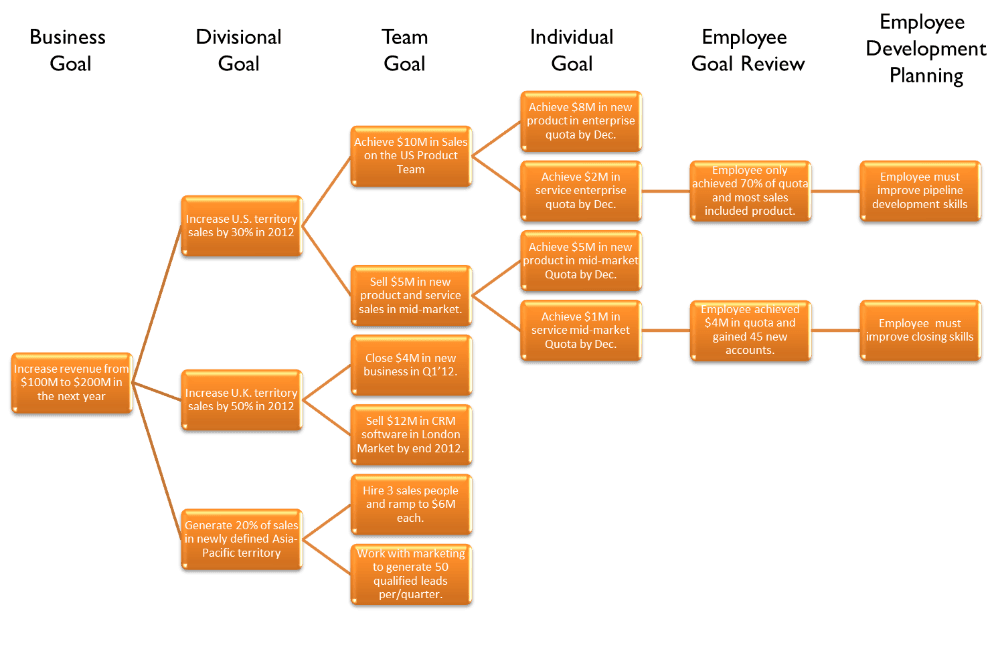In high-performing organisations, goal setting doesn’t start with individual performance plans. It begins at the top, with strategy. Yet too often, performance management systems treat goal setting as a disconnected HR task, resulting in misaligned teams, wasted effort, and disengaged employees. The missing link? Strategic alignment.
There is space for bottom-up approaches, but in larger organisations with layering/silos, a Top-down approach almost becomes an obligation if high performance is the goal.
Too many performance systems confuse busy work with strategic execution. This article explores why goal alignment and contextualization are non-negotiable for organisations seeking real impact.
Contents
Performance Doesn’t Work in Silos
Imagine a manufacturing plant with an operational team focused on reducing lead times by 10%.
It sounds efficient, until you realise senior management is busy firefighting because customer satisfaction is plummeting due to inconsistent product quality.
That’s not a hypothetical. It’s a classic example of goals without alignment.
When strategic alignment is missing:
- Teams optimise local metrics that don’t move the needle for the business.
- Cross-functional friction increases because departments chase different KPIs.
- Leadership loses visibility and trust in the performance management process.
- Employees become disengaged, working hard but seeing little impact.
This isn’t just a productivity issue; it’s a strategic execution failure.
Solution -> Cascade Your Goals.
Strategic alignment doesn’t mean simply pushing corporate goals downward. Creating a goal cascade requires consciously translating enterprise strategy into team-level objectives that support high-level ambitions rather than just mirroring them.
A well-aligned goal-setting framework has three core elements:
| Layer | Description | Example |
|---|---|---|
| Strategic Intent | What the organization aims to achieve | “Increase revenue from $100m to $200m in the next year” |
| Translational Goals | Functional contributions to strategy | US: “Increase US Territory sales by 30%” UK: “Increase US Territory sales by 50%” APAC: “Generate 20% of sales in APAC” |
| Operational Metrics | Day-to-day goals aligned with functional needs | APAC Team: “Hire 3 sales people and ramp to $6m ARR each” |
A mindmap is a clear and structured way of articulating strategy -> Team goals:

Why SMART Goals Alone Aren’t Smart Enough
Many performance systems pride themselves on using SMART (Specific, Measurable, Achievable, Relevant, Time-bound) goals. But without strategic relevance, SMART goals become glorified to-do lists.
Here are two examples of two goals that are both considered SMART Goals, but will have different levels of impact
- ✅ Strategically aligned: “Reduce average resolution time for premium customers to support brand loyalty strategy.”
- ❌ Disconnected: “Answer 20 more customer emails per day.”
Sounds obvious, but goals need to be strategically meaningful.
Contextualize
Alignment isn’t just about pointing everyone in the same direction; it requires translating strategy into something each business layer can understand, act on, and own.
For example, a CEO might have a goal like “accelerate digital transformation.” That’s compelling at an executive level, but a packaging line supervisor has no direct influence over enterprise architecture or cloud migration three layers down. Without contextualization, that goal becomes noise.
Conscious contextualization bridges this gap. Leaders must invest in translating strategy into language and metrics that make sense at every level. What does “accelerate digital transformation” even mean to an operational team struggling with resources and clear processes?
The abstract goal “accelerate digital transformation” might be translated as:
- “Adopt digital tools to shorten sales cycles” by sales
- “Increase machine uptime using predictive analytics” by manufacturing
- “Digitise onboarding and performance reviews” by HR
This doesn’t dilute the goal; it anchors it in relevance. Each unit connects its work to the bigger picture, increasing ownership, clarity, and alignment.
Signs of Misalignment in Your Performance System
Not sure if your organisation has an alignment problem? Look for these red flags:
- Teams hit KPIs, but your intuition is that nothing is moving forward
- You ask yourself, “Why are we doing this?”
- Different departments have conflicting priorities, agendas and political endgames
- Business and personal performance reviews feel perfunctory and a waste of time
If any of those rings true, it’s time to revisit your goal cascade and how well it’s been contextualised.
Practical Tips for Aligning Goals
Here’s how to bring alignment into your performance management rhythm:
- Start with Strategy: Before setting individual goals, ask: What are the top 3 strategic priorities this quarter/year?
- Translate, Don’t Copy: Take the time to interpret this strategy in your context. Don’t just clone OKRs top-down.
- Contextualise with Language that resonates. Use terms and metrics that make sense to the audience, whether in finance, operations, or field sales.
- Review for Relevance: During performance reviews, reflect and ask how each goal supports broader outcomes, not just if it was completed.
- Beware Over-Rigidity: While alignment is critical, performance systems must also leave space for bottom-up feedback. Imposing goals without dialogue risks suppressing innovation and local adaptation. Empowerment and alignment are synergistic.
- Use Performance Analytics: Tools like process mining or BI dashboards can verify if aligned goals lead to strategic results.
- Fit for Purpose: A final point of reflection is to ask, “Are we fit for purpose?” If not, or if it’s not clear what the purpose is, then there is more work to be done
Final Thought: Alignment Unlocks Performance
Goal setting is easy in performance management. Aligning those goals to strategy is hard, but it separates good from great
Strategic alignment is the compass that aligns complex organisations in the same direction. Without it, you risk motivating your team to run fast in the wrong direction.
And without conscious contextualization, that compass might never be seen by the people doing the work.
🎥 Bonus Video: Strategic Planning – Hoshin Kanri Planning – Cascading goals

